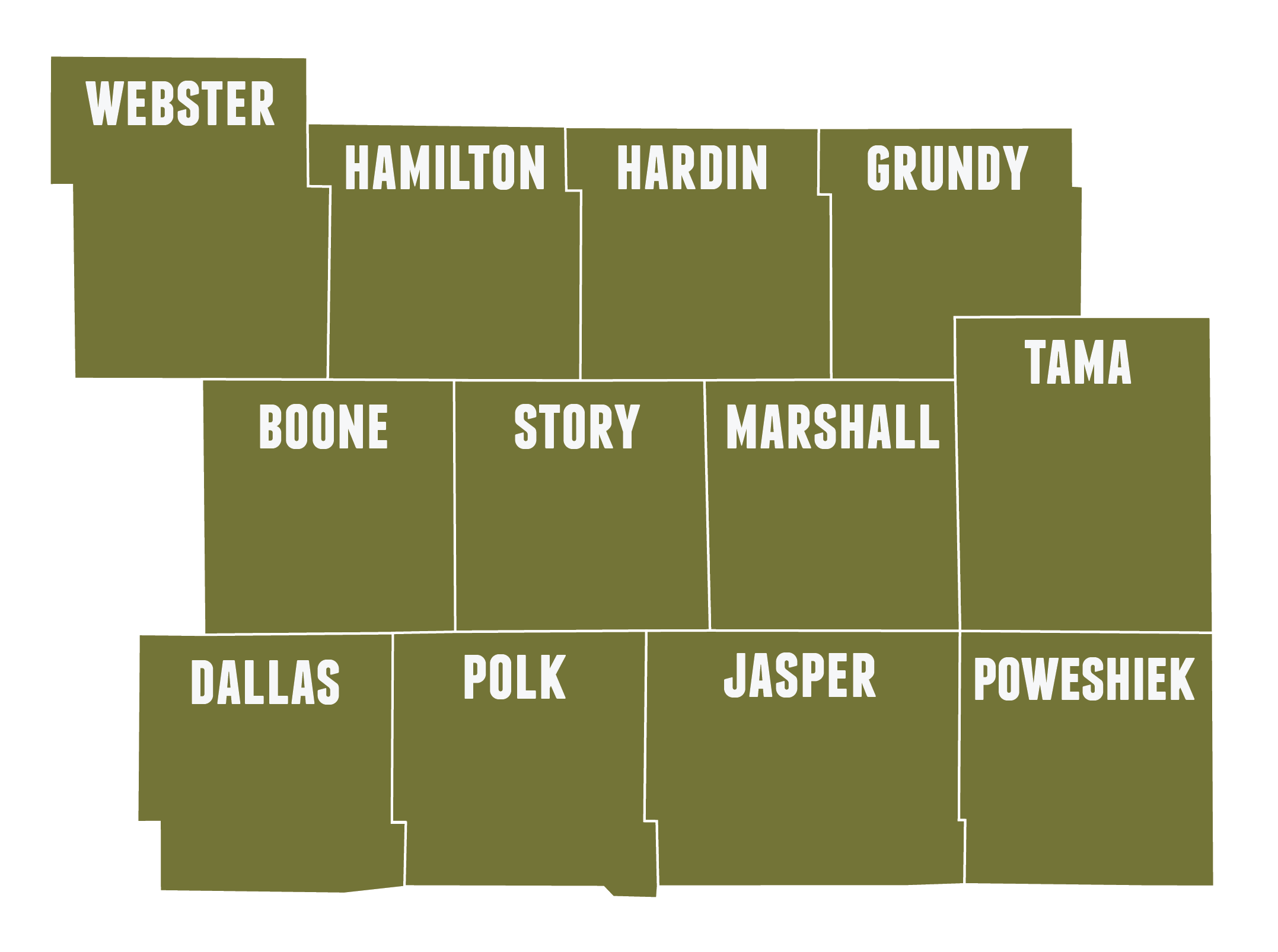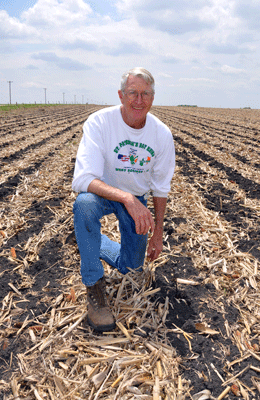
Central Iowa Farmer Partners
District 5 | Back to Farmer Partners Map
Boone County: Rod Pierce
Dallas County: Craig Fleishman | Jeff Koch | Sam Spellman
Grundy County: Fred Abels | Devan Greene
Hamilton County: Arlo Van Diest | Larry Haren
Hardin County: Jacob Bolson
Marshall County: Carl Kurtz | Wade Dooley
Polk: Lee Tesdell
Story County: Mike Hermanson | Brian Sampson | Mark Kenney
Tama County: Mark Pokorny | Kristi Heffelmeier
Webster County: Dan Eklund | Smeltzer Trust Learning Farm | Mark Thompson | AJ and Kellie Blair
Central Iowa Farmer Partner Profiles
While her roots are in rural Iowa, Kristi Heffelmeier began her agricultural journey fairly recently in 2013. After several years teaching in San Antonio, Texas, Kristi chose to move back to the Midwest where she soon realized that her family’s fifth generation farm would someday be left to her. Knowing this, she began working her way into the farming operation with her father Chris Foss. Kristi soon decided to put full focus on the operation and now does everything from field work to bookkeeping. The opportunity to farm also opened doors to further implement conservation practices on the family operation.
When Jacob Bolson was given the opportunity to rent 240 acres in Fall 2020, he and his wife jumped at the chance. In addition to 139 tillable acres, this piece of land has a 30-acre pasture, two wetlands, and Beaver Creek running through it. Knowing his newly acquired ground had been under continuous corn for 10 years and the pasture overgrazed, Jacob immediately implemented conservation management practices to help build up the land.
Mark Kenney is a 5th generation farmer in Story County where he farms corn, soybeans, and seed corn. After growing up in the 80s during the farm crisis he didn’t think he would become a farmer or have a career involved in agriculture at all. When Mark started high school, he had a great ag teacher and FFA advisor who opened students’ eyes to agriculture careers that weren’t involved in production. Mark then went to university in Missouri and majored in ag business with a minor in agronomy. He continued his learning and received a master’s degree in ag economics.
Kellie and AJ Blair farm in Webster County outside of Dayton, IA. After graduating from Iowa State University in 2004, AJ started working alongside his dad on the farm, and Kellie after graduating from ISU worked in various agriculture spaces until she transitioned to farming full-time with her husband in 2017. As fourth-generation farmers, the Blairs are constantly looking for new ways to advance conservation while remaining profitable in Iowa.
The Smeltzer Farm, located southeast of Fort Dodge, is a multi-faceted farm containing almost every conservation structure and practice. From streambank stabilization to terraces, grassed waterways, a bioreactor, saturated buffer, restored oxbow, and farming practice demonstrations including no-till, strip-till and cover crops, the Smeltzer farm serves as a learning tool for farmers. Visitors can come out to see how things are implemented, how the crops are growing and can get pointers from the members of the Smeltzer advisory board. The county naturalist, NRCS conservationist and ISU Extension specialists all work together to make this farm successful.
Dan uses vertical tillage on his corn and soybean acres and also no-till on his corn-on-corn acres. He went to vertical tillage to deal with the high amounts of residue on his land. He has worked with Iowa State University on a number of research projects, and is one of the first farmer partners with Iowa Learning Farms.
Located near Clutier in Tama County, Mark Pokorny began hosting a demonstration site in Fall 2009 for the ILF/PFI cover crop working group. “I was interested in trying a winter rye cover crop for the erosion benefits over winter and in early spring,” Mark said. “I had not considered the nutrient capture, organic matter increases and reduced weed pressure benefits that I saw in 2011.” This past harvest, Pokorny reported higher soybean yield following the cover crop and also saw reduced common waterhemp and lambsquarter weed pressure.
Brian Sampson and his wife Deb raise corn and soybeans as well as operate a cattle feedlot in rural Story County. In 2016, Iowa Learning Farms approached Brian to be a part of a new Conservation Learning Labs (CLL) project that is studying changes in nitrogen and phosphorus loss at the delivery scale.
Larry Haren farms near Webster City in Hamilton County. Over the past 15 years, Haren has applied several conservation practices to his operation including: no-till, cover crops, bioreactor, a soil retention pond, grassed waterways and restoration of oxbows.
ILF farmer partner Arlo Van Diest hopes to leave the soil on his farm in better shape for the next generation. To do this, he converted to strip-till in 2001 and has continued using it ever since. Van Diest grows corn and soybeans on his farm located near Webster City in Hamilton County.
Fred and Vicki Abels farm about 400 acres just outside Holland, Iowa. Fred started farming in 1981 on his family’s farm in Grundy County. It was a traditional soybean and corn rotation with a cow herd. He became interested in conservation practices after attending Practical Farmers of Iowa field days and switched to no-till soybeans in 1994. In the mid-2000s he started strip-till before corn and immediately sold all tillage equipment. In 2009, he started using cover crops, and in the early days, Fred had them custom flown on but then bought a grain drill as he had better germination rates. He no longer has a cattle herd but used to harvest about 20 acres of cover crops to use as cattle feed.
With a lifetime of experience on the farm, Rod Pierce has seen many changes in agriculture over the years. Getting his start in 1973, he has expanded his rural Boone County operation to grow more than 1,600 acres of corn and soybeans. Early in his career, Rod, along with many farmers, used moldboard plows to prepare their soil for planting. Over his many years of farming, he has discovered alternatives to the plow that result in less soil movement and improved soil health. In addition to no-till on some of his acres, Rod also utilizes vertical tillage to redistribute residue and reduce soil disturbance. One of Rod’s recent improvements to his operation was an in-row fertilizer unit on his planter. His hope is to apply nutrients directly where they’re needed to reduce losses.
For nearly 50 years, Carl has been fostering his family’s farm back to the native prairie. He still combines every year, harvesting prairie seed rather than grain, but there is no need for planting or any other inputs. Rather than restarting every year, the prairie’s diversity builds upon itself through Carl’s management of prescribed burns and the physical removal or spot spraying of invasive species.
Mark farms just under 1000 acres in Badger Iowa, about 15 minutes north of Fort Dodge. As a young man, he farmed alongside his father and grandfather, who abandoned the moldboard in the 60s. Continuing his grandfather’s legacy, Mark switched to minimum tillage 20 years ago and cover crops in the last 10 years. He admits that when he first implemented cover crops, there were a few years when he “got burned by not listening to how the older farmers made it work.”
Although Lee didn’t grow up in Iowa, his family has been farming outside Slater since the mid-1800s. Since he returned to the family land in the early 80s, Lee has continually experimented with the cutting edge of conservation practices, while maintaining high levels of productivity. Lee’s strong ethic for water quality has specifically led to the installation of 3 saturated buffers and a bioreactor.
At 10 years old, Wade Dooley had cattle that he cared for, and at 14, he tended field of row crops on his own. After attending ISU and moving to Florida to grow watermelons commercially, Wade returned to Albion in 2008 to become the sixth generation to farm family land. At the time that he returned, he operated 800 acres of row crops and had a 120 cow herd.
Craig Fleishman farms in rural Minburn, Dallas County, where he raises corn, soybeans, oats and hay. He calls his Century Farm “halfway between conventional and organic” and has been using ridge-tillage since 1981 and no-tillage since 1985.
























